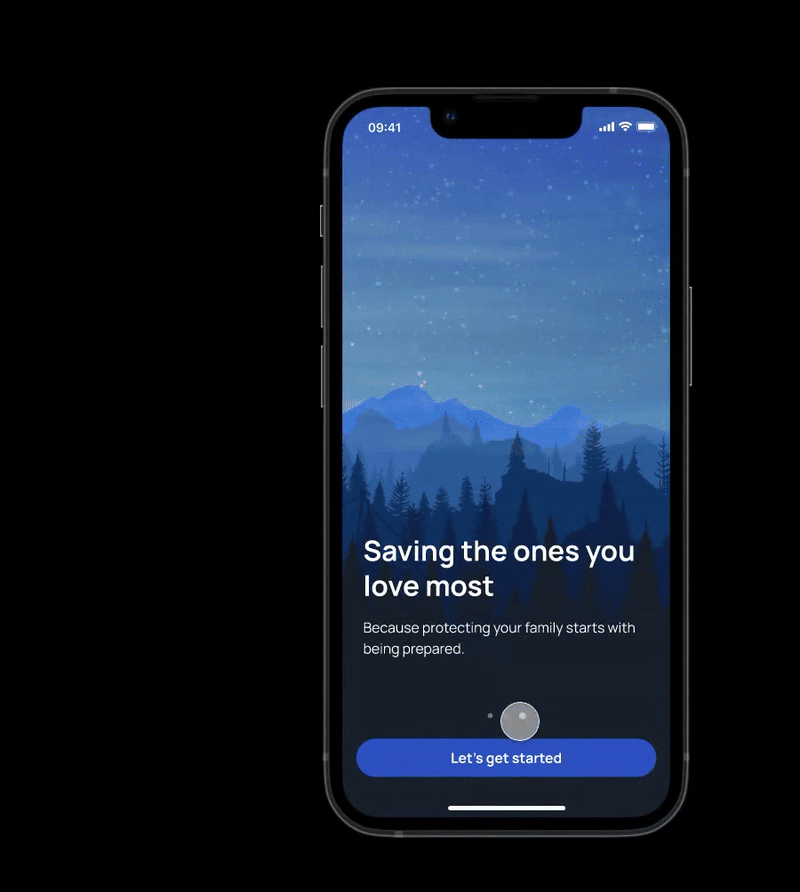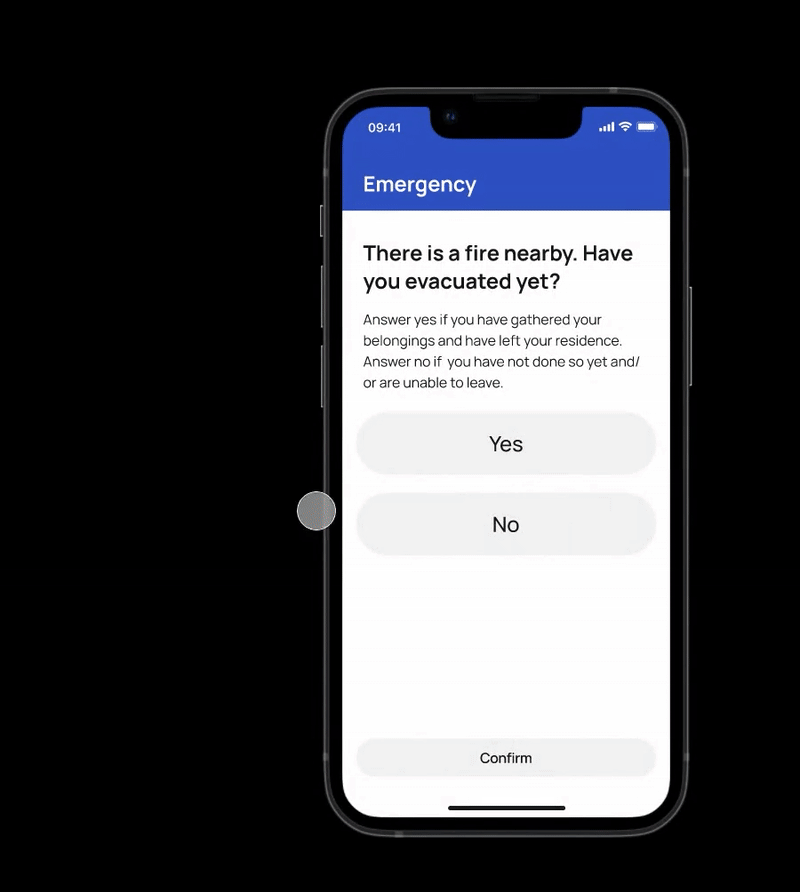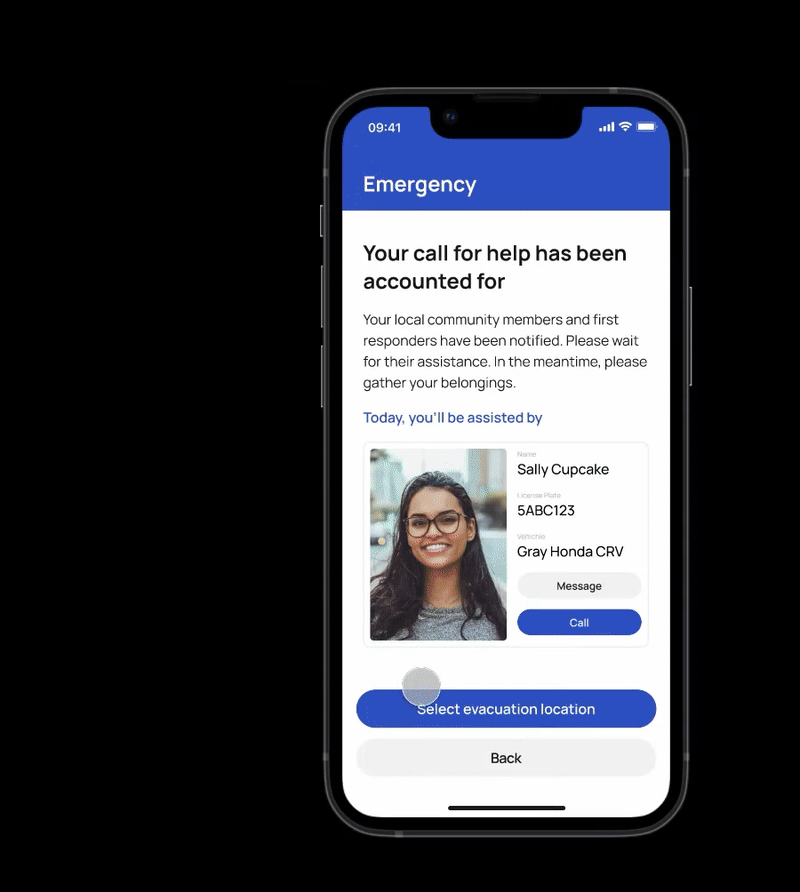




EvacLink
Community-Powered Wildfire Evacuation
🏆 Grand Prize winner and recipient of the “Most Societal Impact” award at UCLA’s ENGR 170: Project-Based Technology Bootcamp for Social Impact, hosted by Innovate@UCLA. EvacLink is a mobile app that helps vulnerable residents—especially people with disabilities—connect with local volunteers and first responders during wildfires.
Timeline:
April-June 2025
Toolkit:
Figma
Maze
Miro
GPT 4.0
Role:
Product Designer
UX Researcher
Team:
1 Product Manager
1 Project Manger
1 Designer & Resarcher
1 Business Analyst
🧭 Overview
EvacLink is a mobile app that connects vulnerable residents, especially people with disabilities, with local volunteers and first responders during wildfire emergencies. By letting users mark their evacuation status and share accessibility needs in real-time, EvacLink helps responders save time and lives.
🤔 The Problem
Wildfires are fast-moving and unpredictable—and the most vulnerable people are often the hardest to evacuate.
In the 2025 Eaton and Palisades wildfires, 30 people died. More than one-third had mobility-limiting disabilities. The system meant to protect them failed.
A 2019 California audit warned that counties lacked disaster planning for people with disabilities. There was no way to track who had evacuated, no data for responders to work with, and no way to mobilize community help in real time.

"California is not adequately prepared to protect its most vulnerable residents from natural disasters."
December 2019 California State Audit
🙋 My Role During the Project
As the Product Designer and UX Researcher, I led all design decisions from ideation to final prototype. I was responsible for defining the user experience, shaping the interface, and ensuring accessibility remained central throughout.
I also organized and conducted all UX research, including interviews with firefighters, disabled evacuees, and community volunteers. I sought out stories from people directly impacted by wildfires to ground our design in real human needs—not assumptions.
From synthesizing insights to driving wireframes, I made sure every decision reflected our users’ realities and the urgency of the problem.
🚶 Organizing Our Workflow
To keep us on track during the 10-week sprint, I set up a Kanban board using Miro. Tasks were organized into To Do → In Progress → Verifying → Done, with tags for role, priority, and deadlines.
This helped us:
-
Stay aligned and accountable
-
Identify blockers early
-
Move quickly without losing clarity
The board became our holy grail—keeping everyone focused and allowing us to make fast, informed decisions throughout the project.

🔎 Preliminary Research
To begin narrowing down our focus, I reviewed personal accounts shared in local news reports, social media posts, and community forums from residents impacted by the 2025 Eaton and Palisades wildfires. Many described moments of confusion, fear, and abandonment—especially among elderly or disabled neighbors who were unsure if help was coming.





"Their rescue ambulance never showed up. It's almost as if the city was short of resources."
Family Member of Fire Victim
🗣️ Insights from the Front Line
To better understand the issues caused by the disasterous wildfire evacuation protocol, I also organized interviews with those working throughout and affected by the Palisades and Eaton Fires to better understand evacuation for disabled and elderly populations, including:
-
Firefighters and emergency responders
-
Wheelchair users and disabled evacuees
-
CERT (Community Emergency Response Team) volunteers
-
Accessibility advisors
Our key takeaways:

First responders waste critical time checking homes that are already empty

Disabled users fear being mishanlded or left behind

Volunteers are willing to help but don’t know who needs it

Many evacuees can't type or speak clearly under stress
So what can we do? We can...
Build a tool that enables safe, real-time coordination between evacuees and those who can help—prioritizing accessibility and trust.
👤 User Personas
Using our research, we utilized AI-tools to consolidate the 10 interviews we conducted to develop three main personas to represent core users, which shaped our thinking from start to finish.



📖 Storyboarding
We mapped out what users might experience during a wildfire—physically, emotionally, and logistically. Through storyboarding, we visualized how someone with limited mobility or communication challenges might interact with the app in real-time.
These scenarios helped us identify pain points, prioritize accessibility, and ensure our design choices felt realistic under pressure. It also gave our team a shared understanding of the urgency and empathy needed in every user interaction.

🧠 Brainstorming
I then consolidated all our notes, interviews, and sketches, where I led brainstorming ideas that we would execute in the 10-week timeframe. As only two of our team members were familiar with designing sketching, our brainstorming process included hand-drawn sketches, doodles on Miro, and renders from GPT 4.0's image generation.
Then, as a team, we voted on the core features of our application, with our project manager supporting our final decisions.

➡️ User Flows
We initially sketched several user flows, exploring different ways to facilitate communication between evacuees, volunteers, and responders. After going back and forth on feasibility, impact, and alignment with our core goals, we reviewed our concepts with mentors and interview participants.



Ultimately, we narrowed our focus to three essential flows that balanced usability, urgency, and accessibility:
-
Evacuee Signup & Profile
Users can pre-load critical information—medical conditions, mobility limitations, language preferences, and emergency contacts. This data remains private and is only activated during declared emergencies. -
Evacuation Check-In
During a wildfire event, users can mark their status as Safe, Unsafe, or Need Help. They can leave a short voice, text, or video message with context. AI then summarizes these into quick tags for responders (e.g., “leaking gas,” “cat in basement”). -
Volunteer Match & Guidance
Volunteers are matched with nearby evacuees based on location, urgency, and vehicle type. They receive navigation support, evacuation tips, and a pre-approved list of safe zones.
These three flows worked in tandem to support our mission: empowering vulnerable residents and streamlining help when every second counts.

✒️ Prototyping
Here's an overview of the designs I created using our flows!

🌟 Final Designs
Since the core of this project was the research aspect, we were only given a week to design our product to pitch, so using Figma to prototype and design, I whipped out our product in a matter of hours!

Sign-Up
Evacuees can sign up on their own or even be assisted by a caretaker or family member!

Evacuation Check
During an emergency, users have a way to indicate if they're safe. If not safe, they're given methods to respond, depending on their preference.

Volunteer Connect
Local community volunteers with background checks get notified of neighbors who need assistance and will be directed in ways to help them.
Accounting for Accessibility
In 2024, ADA laws were updated to include web accessibility, with compliance deadlines set for 2026. That means all digital tools—especially emergency-related ones—need to meet WCAG 2.1 AA standards. After working with advisors from the UCLA Web Accessibility Initiative, we’ve ensured our app meets those standards across the board.
One of our features is a voice recording tool, because speaking is often the fastest and most natural way to leave a message during an emergency. But we didn’t stop there.
To serve as many people as possible, we’ve also added:
-
A text input option
-
A video feature that detects sign language
-
And support for all languages, so that no one is left out due to how they communicate.

💬 Presentation Pitch
We presented EvacLink live at the UCLA ENGR 170 showcase. Judges included tech execs, investors, and civic leaders. Check the slides below to see our presentation!
🎉 EvacLink won the Grand Prize and “Most Societal Impact” award!

🌱 What I Learned
We started by storyboarding wildfire scenarios—visualizing what users might feel, need, and struggle with in real time. This helped us design with empathy and urgency from day one.
Accessibility wasn’t an add-on—it was built in from the ground up: voice and text input, sign language support, screen reader compatibility, and multilingual UI. Feedback from accessibility advisors was crucial.
We used AI to transcribe messages, extract key hazards, and generate clear responder summaries—cutting through chaos to speed up decisions.
I also explored privacy principles, including HIPAA and data encryption (AES-256), to ensure trust through opt-in sharing and secure flows.
Takeaways:
-
Accessibility is a core product feature
-
Emergencies demand calm, clear UI
-
Trust and privacy are non-negotiable
-
Good tech supports community, not just efficiency
Next, I’m excited to explore scaling EvacLink to other disasters, supporting offline users, and piloting with local governments.
🙌 Special Thanks
Team:
Edwin Feinberg, Mehrnaz Bastani, Chloe Vincent
Coach:
Josh Cable
Judges:
Rohan Sharma, Deepa Iyengar, Doug Goetz, Bonny Bentzin
UCLA Advisors:
Jim Davis, Davida Johnson
Accessibility Mentors:
Carolanne Link, Travis Lee
Program:
ENGR 170 - Innovate@UCLA


























